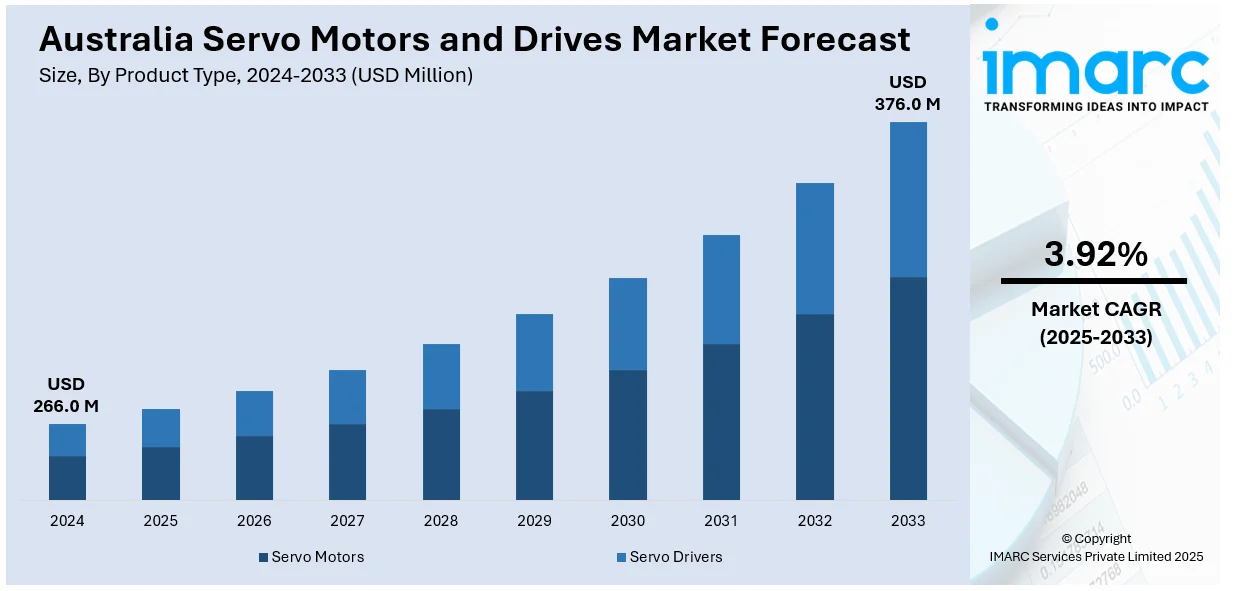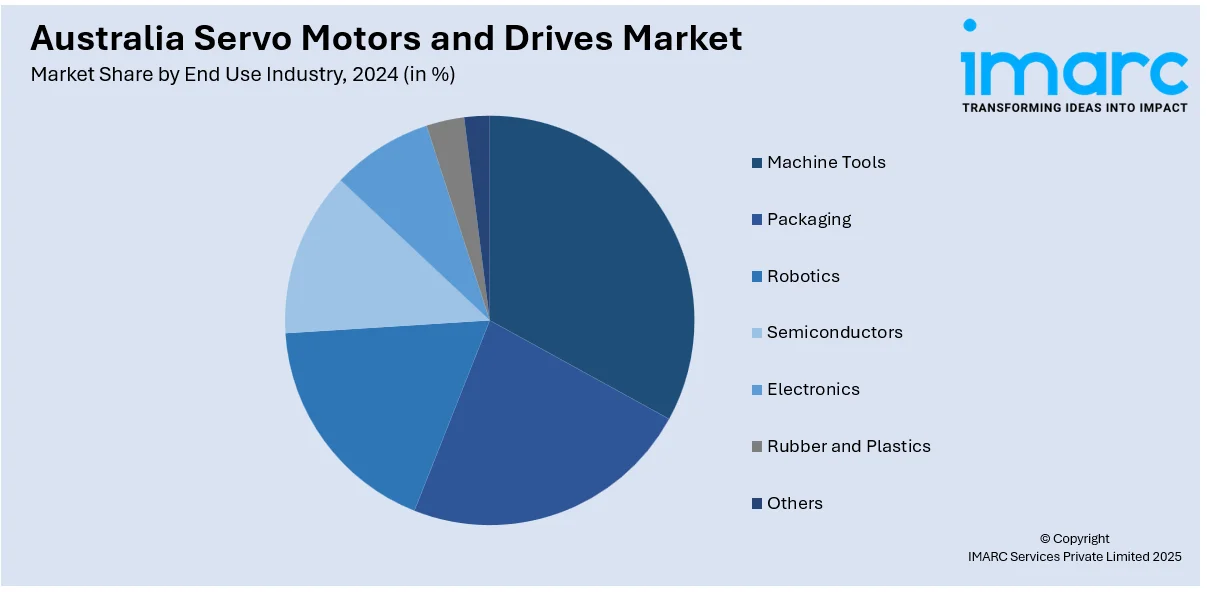
Australia Servo Motors and Drives Market Size, Share, Trends and Forecast by Product Type, Voltage Range, System, Communication Protocol, End Use Industry, and Region, 2025-2033
Australia Servo Motors and Drives Market Overview:
The Australia servo motors and drives market size reached USD 266.0 Million in 2024. Looking forward, IMARC Group expects the market to reach USD 376.0 Million by 2033, exhibiting a growth rate (CAGR) of 3.92% during 2025-2033. The market is driven by the growing demand for automated technologies for improving productivity, efficiency, and safety, rising investment in renewable energy infrastructure, and technological advancements in robotics and smart manufacturing to enhance operational flexibility and minimize downtime.
|
Report Attribute
|
Key Statistics
|
|---|---|
|
Base Year
|
2024 |
|
Forecast Years
|
2025-2033
|
|
Historical Years
|
2019-2024
|
| Market Size in 2024 | USD 266.0 Million |
| Market Forecast in 2033 | USD 376.0 Million |
| Market Growth Rate 2025-2033 | 3.92% |
Australia Servo Motors and Drives Market Trends:
Rising Demand for Industrial Automation Across Sectors
The drive for industrial automation in Australia is impelling the growth of the market. As industries like manufacturing, mining, food processing, and logistics become increasingly reliant on automated technologies for improving productivity, efficiency, and safety, the demand for precision motion control components is increasing. Servo drives and motors provide high torque density, accurate speed control, and reliability, suitable for automated equipment, robotic systems, and computer number control (CNC) machines. The manufacturing industry in the country, especially, is adopting Industry 4.0 technologies, which focus on connected and intelligent systems. The efforts of the Australian Government to support advanced manufacturing capabilities through funding and innovation grants also promote the adoption of automation solutions. Moreover, labor deficiencies in some technical positions and maintaining global competitiveness are facilitating the transformation towards intelligent motion control systems, rendering servo technologies a necessity for contemporary production scenarios. In 2024, the government launched a $22.7 Future Made in Australia Plan to conduct advanced manufacturing in Australia and build a stronger and resilient economy.

To get more information on this market, Request Sample
Growth in Renewable Energy and Sustainability Initiatives
Australia's growing investment in renewable energy infrastructure is supporting the growth of the market. With the nation shifting to cleaner energy resources, including solar and wind power, the installation of automated tracking and positioning systems in renewable energy installations is rising. Servo systems play a critical role in applications, such as solar panel tracking, where they make panels align with the position of the sun to ensure maximum energy capture. In addition, Australia's national and state-level sustainability policies are encouraging energy-efficient technologies, such as high-performance and low-power motors and drives. The application of Minimum Energy Performance Standards (MEPS) is also encouraging industries to upgrade old motors with more efficient ones. Servo motors, with their low power consumption and high precision control, are well-suited to these green objectives and so are a popular pick in green manufacturing operations and smart energy infrastructure developments. As per an article published by Clean Energy Council, overall, 4346 MW of new generation capacity were approved in Australia for build during 2024 worth more than $9 billion of capital expenditure, together with over 10,000 jobs during the construction phase.
Advancements in Robotics and Smart Manufacturing Technologies
Technological improvements in robotics and smart manufacturing are positively influencing the market in Australia. With industries embracing smart machinery and collaborative robots (cobots) to enhance operational flexibility and minimize downtime, the demand for advanced motion control systems is growing. Servo motors are used in robotic joints, end-effectors, and precision assembly systems because they can provide high-speed, precise, and repeatable motion. Australia's significant emphasis on high-tech manufacturing, particularly in industries, such as aerospace, medical devices, and defense, is also augmenting the need for these components. Adoption of artificial intelligence (AI), machine learning (ML), and internet of things (IoT) technologies in manufacturing environments is also generating prospects for sophisticated servo systems with embedded feedback and real-time diagnostics. As per the information provided by the IMARC Group, the Australia IoT market size is expected to reach USD 90.61 Billion by 2032.
Australia Servo Motors and Drives Market Segmentation:
IMARC Group provides an analysis of the key trends in each segment of the market, along with forecasts at the region level for 2025-2033. Our report has categorized the market based on product type, voltage range, system, communication protocol, and end use industry.
Product Type Insights:
- Servo Motors
- Servo Drives
The report has provided a detailed breakup and analysis of the market based on the product type. This includes servo motors and servo drives.
Voltage Range Insights:
- Low Voltage
- Medium and High Voltage
A detailed breakup and analysis of the market based on the voltage range have also been provided in the report. This includes low voltage and medium and high voltage.
System Insights:
- Linear System
- Rotary System
A detailed breakup and analysis of the market based on the system have also been provided in the report. This includes linear system and rotary system.
Communication Protocol Insights:
- Fieldbus
- Industrial Ethernet
- Wireless
A detailed breakup and analysis of the market based on the communication protocol have also been provided in the report. This includes fieldbus, industrial ethernet, and wireless.
End Use Industry Insights:

- Machine Tools
- Packaging
- Robotics
- Semiconductors
- Electronics
- Rubber and Plastics
- Others
A detailed breakup and analysis of the market based on the end use industry have also been provided in the report. This includes machine tools, packaging, robotics, semiconductors, electronics, rubber and plastics, and others.
Regional Insights:
- Australia Capital Territory & New South Wales
- Victoria & Tasmania
- Queensland
- Northern Territory & Southern Australia
- Western Australia
The report has also provided a comprehensive analysis of all the major regional markets, which include Australia Capital Territory & New South Wales, Victoria & Tasmania, Queensland, northern territory & southern Australia, and western Australia.
Competitive Landscape:
The market research report has also provided a comprehensive analysis of the competitive landscape. Competitive analysis such as market structure, key player positioning, top winning strategies, competitive dashboard, and company evaluation quadrant has been covered in the report. Also, detailed profiles of all major companies have been provided.
Australia Servo Motors and Drives Market Report Coverage:
| Report Features | Details |
|---|---|
| Base Year of the Analysis | 2024 |
| Historical Period | 2019-2024 |
| Forecast Period | 2025-2033 |
| Units | Million USD |
| Scope of the Report | Exploration of Historical Trends and Market Outlook, Industry Catalysts and Challenges, Segment-Wise Historical and Future Market Assessment:
|
| Product Types Covered | Servo Motors, Servo Drives |
| Voltage Ranges Covered | Low Voltage, Medium and High Voltage |
| Systems Covered | Linear System, Rotary System |
| Communication Protocols Covered | Fieldbus, Industrial Ethernet, Wireless |
| End Use Industries Covered | Machine Tools, Packaging, Robotics, Semiconductors, Electronics, Rubber and Plastics, Others |
| Regions Covered | Australia Capital Territory & New South Wales, Victoria & Tasmania, Queensland, Northern Territory & Southern Australia, Western Australia |
| Customization Scope | 10% Free Customization |
| Post-Sale Analyst Support | 10-12 Weeks |
| Delivery Format | PDF and Excel through Email (We can also provide the editable version of the report in PPT/Word format on special request) |
Key Questions Answered in This Report:
- How has the Australia servo motors and drives market performed so far and how will it perform in the coming years?
- What is the breakup of the Australia servo motors and drives market on the basis of product type?
- What is the breakup of the Australia servo motors and drives market on the basis of voltage range?
- What is the breakup of the Australia servo motors and drives market on the basis of system?
- What is the breakup of the Australia servo motors and drives market on the basis of communication protocol?
- What is the breakup of the Australia servo motors and drives market on the basis of end use industry?
- What are the various stages in the value chain of the Australia servo motors and drives market?
- What are the key driving factors and challenges in the Australia servo motors and drives market?
- What is the structure of the Australia servo motors and drives market and who are the key players?
- What is the degree of competition in the Australia servo motors and drives market?
Key Benefits for Stakeholders:
- IMARC’s industry report offers a comprehensive quantitative analysis of various market segments, historical and current market trends, market forecasts, and dynamics of the Australia servo motors and drives market from 2019-2033.
- The research report provides the latest information on the market drivers, challenges, and opportunities in the Australia servo motors and drives market.
- Porter's five forces analysis assist stakeholders in assessing the impact of new entrants, competitive rivalry, supplier power, buyer power, and the threat of substitution. It helps stakeholders to analyze the level of competition within the Australia servo motors and drives industry and its attractiveness.
- Competitive landscape allows stakeholders to understand their competitive environment and provides an insight into the current positions of key players in the market.
Need more help?
- Speak to our experienced analysts for insights on the current market scenarios.
- Include additional segments and countries to customize the report as per your requirement.
- Gain an unparalleled competitive advantage in your domain by understanding how to utilize the report and positively impacting your operations and revenue.
- For further assistance, please connect with our analysts.
 Request Customization
Request Customization
 Speak to an Analyst
Speak to an Analyst
 Request Brochure
Request Brochure
 Inquire Before Buying
Inquire Before Buying




.webp)




.webp)












